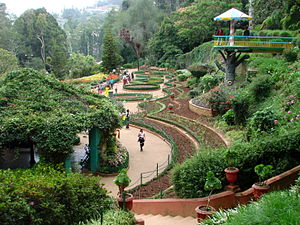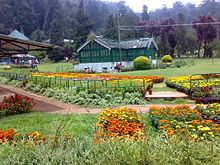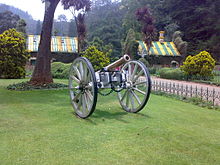- Government Botanical Gardens, Ooty
-
Government Botanical Garden
Government Botanical Garden, OotyType Botanical Garden Location Ooty (Udhagamandalam) 11°25′08″N 76°42′40″E / 11.418752°N 76.711038°ECoordinates: 11°25′08″N 76°42′40″E / 11.418752°N 76.711038°E Size 55 acres Number of species 650[1] Collections Cork tree, Paper bark tree, Monkey puzzle tree[2] Opened 1847[1] Owned by Government of Tamil Nadu Operated by Horticulture Department, Government of Tamil Nadu Status Open The Government Botanical Gardens is a botanical garden in Udagamandalam (Ooty), Tamil Nadu state, India, were laid out in 1847.[3] The Gardens, divided into several sections, cover an area of around 22 hectares, and lie on the lower slopes of the Doddabetta peak.[4] The garden has a terraced layout. It is maintained by the Tamil Nadu Horticulture Department.[5]
It ascends the slopes of the hill at an elevation of 2400–2500 metres above Mean Sea Level.[2] The garden enjoys a warm temperate climate, with an average rainfall of 140 cms, the most of which is received during south-west monsoon, with frosty nights from November to February. The maximum and minimum temperatures are 28°C and 0°C respectively.[6]
Contents
History
The government botanical garden was started in 1847. Its architect was William Graham McIvor.[7] The Marquis of Tweedale prepared the initial layout during the late 1840s. The gardens were established by a subscription of Rs 3 per month amongst the European residents for the purpose of supplying vegetables at a reasonable cost. During the time that Ootacamund was under British military control, considerable cultivation of vegetable for the market was carried on by the European settlers and others. Captain Molyneux of the 2nd European Regiment managed vegetable cultivation. The site occupied is the present new garden. The subscriber received the vegetables free of cost. But this arrangement did not work out and in early 1847, a fund was raised by means of donations and subscriptions with a view to form a horticultural society and a public garden.
There were very few horticulturists at that time. Seeds and saplings were not available locally, but were available in the jungles that surrounded them. Hence, it was proposed to establish a public garden. For this purpose, a wood was selected between Lushington Hall (the Present Hebron School) and General Sewell’s Property (the present Raj Bhavan). Shortly after formation of the society, the committee requested for state aid for providing a scientific and practical gardener and granting funds to meet his salary. This suggestion was accepted and Mr.W.G.McIvor from the Royal Botanic Gardens, Kew was sent to Ootacamund. He arrived in March 1848, converted the upper portion, which was a forest, and the lower portion, which was a swamp, into a beautiful garden. He took ten years to complete the layout of the Garden.
Collections
The Gardens have around a thousand species, both exotic and indigenous, of plants, shrubs, ferns, trees, herbal and bonsai plants.[8] In the centre of the Gardens lie a fossilized tree trunk estimated to be 20 million years old. The Gardens consist of several lawns with flowering plants, ponds with lilies, beds of flowers and ferns laid out in an Italian style, several plots of flowering plants, a variety of medicinal plants.
Sections
The present Botanical Garden is divided into 5 sections namely Lower Garden, New Garden, Italian Garden, Conservatory, Fountain Terrace and Nurseries.[2][5]
Lower Garden
The lower garden comprises the entrance and the lower lawns. The entrance of the garden leads into an extensive lush green lawn of Kikiyu grass (Pennisetum Clandestinum) which is known for its springy vigour.[6] A fern house with 127 species of ferns is situated on the left along the road leading to Raj Bhavan (Ooty) amidst another expanse of lawns and historic gatehouses. The prime attractions in this section are the carpet-bet design of the map of the Indian Union laid out with selective plants and the fossil trunk of 20 million years old, erected on a pedestal.[9]
Tree species of botanical interest such as Hymnosporum flavum, Cordylline australlis, Cedrus deodara, Cupressus funebrils, Araucaria bidwillii, Cupressus macrocarpa, Cryptomeria japonica, Eucalyptus maculate, Eucalyptus citriodora, Salix babylonica, Salix heterophylla, Podocarpus taxifolia, Dracena lanuginosa, Pinus patula, Rhododendron arboreum, Quercus Montana, Quercus cerris, Quercus Serrata, Quercus grilffithi, Quercus illex, Magnolia grandiflora etc., can be seen alongside the lawn.[9]
New Garden
The New garden developed recently, comprises the area between the front garden and the crescent-shaped pond at the bandstand. This section consists of:
- A rose garden with three hundred varieties of Hybrid Tea Roses, Floribunda and Polyanthas rose varieties.
- Large number of flowerbeds designed to match the slopes and contour of this area.
- Carpet-bed emblems of the Government of Tamil Nadu and the Government of India.
- Natural ponds with aquatic plants.[9]
Important tree species such as Taxodium mucronatum, Pieris ovalifolia, Juniperus virginiana, Eucalyptus eugenoides, Pinus wallichiana, Photinia lindleyana, Pinus canaariensils, Ginkgo biloba, Araucaria cunninghammi and Cupressus lawsoniana are planted all over the section.[9]
Italian Garden
This garden was first laid out by Italian prisoners of World War I, who were shifted to Ooty. They were placed under the control of the Military station in Ootacamund. Asters, ageratum, balsam, begonia, petunia, pansy, phlox, cosmos, zinnia and perennial flowers like salvia, delphinium, larkspur, and dahlia are the main attraction in this garden.[9]
The informal landscape of the garden from the entrance, merge into the formal fashioned beds laid out in an Italian pattern, surrounding the centrally situated octagonal bandstand. This part of the garden looks attractive with several varieties of colourful annuals. In the foreground, is a crescent-shaped lily pond for growing several varieties of aquatic plant species. The tree species grown in this part of the garden are Prunus cerasoides, Saurauja nepaulensis, Grevillea hilliana, Aesculus punduana, Pinus sabineana, Cupressus torulosa, Syncarpia glomulifera, Pinus roxburghii, Albizzia julibrissin etc.[9]
The Conservatory
The public conservatory was constructed in 1912 with the objective of grouping various flowering plants. Colourful annuals and perennials like Cineraria, Schizanthus, Calceolaria, Balsam, Cyclamen, Gloxinia, Tuberous begonia, Coleus, Geranium, Chrysanthemum, Primulas, Tydea, Achemenes etc., find a place in this conservatory.[9]
The bog garden lies towards the east of this conservatory and forms an adjunct to provide a good site for marsh loving plants such as the Weeping willow, Hedychium, Arum, Hydrangea etc.[9]
The Nurseries
The nurseries which are about 300 feet above the lower lawns, consist of eight glass-houses and a series of terraces for introduction and breeding of exotic plants. The glass-houses are utilized for growing Begonias, Ferns, Cacti, Succulents, Orchids and Bulbous plants for providing a continuous supply of potted plants to be grouped periodically in the conservatories. The terraces are utilised for growing plants for cut flowers, seed and also for trial purposes.[9]
The Flower Show
The first Flower Show was organised in the year 1896 by the Chairman of Nilgiris Agri-Horticultural Society, Mr.J.H.Tremenhere, the then Collector of Nilgiris.[10] The Government has taken over the flower show from the Nilgiris Agri-horticultural society in 1980 by forming a committee called the Nilgiris Flower and Fruit Show Committee. The flower show attracts about 150,000 tourists each year from all over the world.[11]
The flower show is held for two days.[12] The inauguration of the show is held on the first day and on the second day, prizes are distributed to winners of various competitions held in connection with flower show. About 250 exhibitors participate in different categories on the day of flower show. Several government departments and voluntary agencies also display their activities for the benefits of the flower lovers and tourists.
More than 50 varieties of potted plants, 150 varieties of cut flowers, various kinds of tropical and temperate vegetables and tropical and temperate fruits are exhibited by the competitors. The Floral decorations, Indian and Japanese flower arrangements, Vegetable carving, Flower Rangoli, Bonsai etc., are the major attractions during the show days. The exclusive cut flower stalls from large private and public gardens are also an attraction during the show days. 59 rolling cups, 250 cups and cash prizes are awarded to the best competitors and exhibitors.
A garden competition is also held involving Estate Gardens, Private Cottage Gardens, Public Gardens and various other categories of gardens, to create greater awareness among flower growers.[10] On an average, about 200 gardens compete in the event. Garden competition is held prior to the flower show and best gardens are awarded prizes and cups.
The Fossil Tree Trunk
The fossil tree trunk displayed in the garden is from 20 million years old.[13] Trees carried by rivers and deposited in inland lakes were transformed with replacement of the woody matter by silica give rise to fossil tree trunks (see Polystrate fossil). The fossil tree was presented by the Geological Survey of India, from the National Fossil Park, Tiruvakkarai, South Arcot district, Tamil Nadu.[5]
The Toda Mund
The Garden is also famous for the Toda hill called the Toda mund. This place gives the visitors an insight into the lives of the original tribes of Ooty called the Todas.[14]
Photo Gallery
See also
References
- ^ a b "Peaks of pleasure". Dnaindia.com. http://www.dnaindia.com/entertainment/report_peaks-of-pleasure_1137638. Retrieved 2011-01-22.
- ^ a b c "GOVERNMENT BOTANICAL GARDEN". Nilgiris.tn.gov.in. http://www.nilgiris.tn.gov.in/ooty.htm. Retrieved 2011-01-22.
- ^ "Ooty Botanical Garden". Ooty.com. http://www.ooty.com/travel/botanicalgarden.htm. Retrieved 2011-01-22.
- ^ "Archive for the ‘States of South India’ Category-Botanical Garden". India-tourist-places.com. http://www.india-tourist-places.com/category/states-of-south-india/page/3/. Retrieved 2011-01-22.
- ^ a b c "Tamil Nadu - Government Botanical Garden". Scstsenvis.nic.in. http://scstsenvis.nic.in/envis/new_page_53.htm. Retrieved 2011-01-22.
- ^ a b "ooty botanical garden". Tourismindiatoday.com. http://www.tourismindiatoday.com/ooty-botanical-garden. Retrieved 2011-01-27.
- ^ D, Radhakrishnan (09 Jun 2009), "A tribute to creator of Ooty Botanical Garden", The Hindu (India), http://www.hindu.com/2009/06/09/stories/2009060951000200.htm
- ^ "Ooty to host spices show for first time", The Hindu (India), 11 Mar 2010, http://www.hindu.com/2010/03/11/stories/2010031157580500.htm
- ^ a b c d e f g h i "Places of Interest". Nilgirislive.com. http://nilgirislive.com/nlnilpointerest.html. Retrieved 2011-01-27.
- ^ a b "Ooty flower show opens today", The Times of India (India), 17 Mat 2002, http://timesofindia.indiatimes.com/city/Ooty-flower-show-opens-today/articleshow/10195215.cms
- ^ "Flower show in Ooty attracts tourists from across the country and abroad". Newsagency.thecheers.org. http://newsagency.thecheers.org/South-Asia/news_24223_Flower-show-in-Ooty-attracts-tourists-from-across-the-country-and-abroad.html. Retrieved 2011-01-22.
- ^ "FLOWER SHOW". Nilgiris.tn.gov.in. http://www.nilgiris.tn.gov.in/flower_show.htm. Retrieved 2011-01-22.
- ^ "Hills beckon again". Tribuneindia.com. http://www.tribuneindia.com/2003/20030510/windows/main1.htm. Retrieved 2011-01-22.
- ^ "Tourism - Ooty". Tncsc.com. http://www.tncsc.com/tncsc/index.php?option=com_content&view=article&id=132&Itemid=95&limitstart=13. Retrieved 2011-01-22.
Further reading
- LLC, Books (2010). Ooty: Ootacamund, Nilgiri Mountain Railway, Government Botanical Gardens, Udagamandalam, Hebron School, Ooty, Raj Bhavan, Doddabetta, Pykara. General Books. ISBN 115834662X.
- Negi, Sharad Singh (2010). Biodiversity and its conservation in India. Indus Publishing Company. pp. 297. ISBN 81-85182-88-4.
External links
- Ooty/Udhagai/Udhagamandalam/Ootacamund Official history and tourism page on www.nilgiris.tn.gov.in. (This site is maintained by the District Administration of the Nilgiris)
Tourism in The Nilgiris Gardens and Parks  Botanical Garden Ooty · Rose Garden Ooty · Sim's Park Coonoor · Mukurthi National Park · Mudumalai National Park · Bandipur National Park · Droog Fort · Lady Canning Seat
Botanical Garden Ooty · Rose Garden Ooty · Sim's Park Coonoor · Mukurthi National Park · Mudumalai National Park · Bandipur National Park · Droog Fort · Lady Canning Seat
View Point  Doddabetta · Lamb's Rock · Dolphin's Nose · Needle hill viewpoint · Ketti Valley view · Kodanad View Point · Rangaswamy Peak and Pillar · Needle Rock View Point · Frog Hill View Point · Western Catchments
Doddabetta · Lamb's Rock · Dolphin's Nose · Needle hill viewpoint · Ketti Valley view · Kodanad View Point · Rangaswamy Peak and Pillar · Needle Rock View Point · Frog Hill View Point · Western CatchmentsLake and Water Falls  Ooty Lake · Pykara Lake · Upper Bhavani Lake · Emerald Lake · Avalanche Lake · Porthimund Lake · Pykara water falls · Kalhatti falls · Law's falls · Kateri falls · Catherine Falls · Kamaraj Sagar Dam
Ooty Lake · Pykara Lake · Upper Bhavani Lake · Emerald Lake · Avalanche Lake · Porthimund Lake · Pykara water falls · Kalhatti falls · Law's falls · Kateri falls · Catherine Falls · Kamaraj Sagar DamOther Tourist spots Nilgiri Mountain Railway · Adam's fountain · Ooty Golf Course · Stone House, Ooty · Toda huts · Ooty Racecourse · Nilgiri mountains · Ooty Radio Telescope · Gori sholaEvents  Summer Festival
Summer FestivalTourism in Tamil Nadu · Tourism in India · Ooty · Coonoor · Gudalur · Kotagiri
Categories:- Botanical gardens in India
- Ooty
- 1847 establishments in India
- Tourism in Tamil Nadu
- Nilgiris District
Wikimedia Foundation. 2010.














